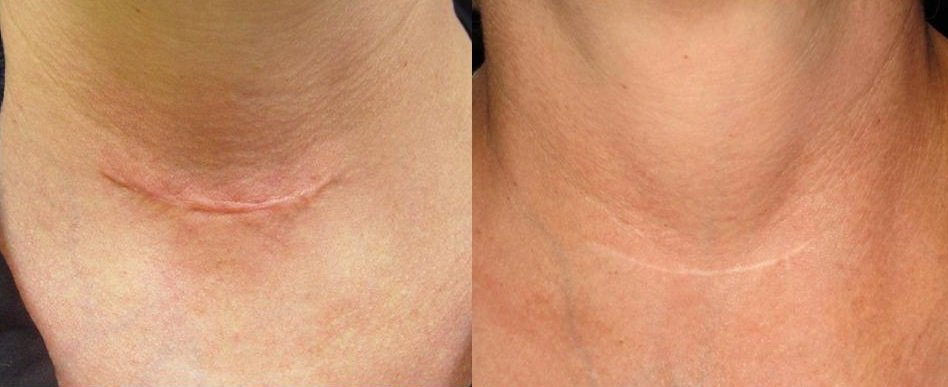Scar Treatment
Treating Scars at MaxAesthetics in Philadelphia
Types of Scarring
Scars are the fibrous tissue that replaced normal skin as a natural part of the healing process.
The choice in scar treatment that will be best for you depends on your type of scar or scars. There are a lot of factors that influence the type of scarring that develops:
- How the skin was damaged
- The severity of the injury
- How well the skin heals; how long it takes to heal and your family history of scarring determine the look of the scar.
- Complications during the healing process such as infection and inflammation can make scars worse.
- Injuries in places of tension, like joints, tend to heal more slowly.
- Age also slows the healing process, so elderly people scar much more severely.
- Skin type, genetics, hormones also influence the appearance and severity of the scars.
An injury is not a scar until it is completely healed. The redness that accompanies an injury during healing is not a scar, and will eventually fade.
At MaxAesthetics, we may utilize a combination approach to treating scars depending on the type of scar, the severity and the individual skin type. Some scars may not be able to be treated so we encourage you to call us for a free consultation to determine the best treatment options for you.
Interested in scar reduction treatments?
Fill out our client form & upload pictures of your scar to be treated.
Different Types of Scars
Fortuna -The most common type of scar is the fortuna scar, usually from minor injuries. Fortuna scars are characterized as pale, flat and leaving a trace of the original injury.
Keloids– When the body produces too much collagen during the healing process, a hypertrophic or keloid scar may form. Scar tissue of a keloid covers the wound and extends into the surrounding skin. Keloid scarring is prevalent in people of color and can be caused by any trauma from accidents, acne or even body piercing.
Hypertrophic Scars– Similar to a keloid scar in that they are raised, but they do not extend upon the boundaries of the initial wound. A hypertrophic scar may fade over time without intervention. Hypertrophic scars are raised deposits of scar tissue, usually pink or redness in color. A hypertrophic scar tends to gradually grow during the first few weeks, then slowly fade.
Atrophic Scars –A sunken scar that form a depression due to damage to collagen, fat and other underlying tissues. Acne, chicken pox, surgery and accidents can cause these types of scars. Most acne scars are atrophic, including ice pick or pitted scars, boxcar scars and rolling scars. Acne scars tend to be either rolling scars or ice pick. Find out how or process of treating acne scars and treatment to remove acne scars.
Scar Contractures – These types of scars are burn scars. Scar contractures tighten the affected skin. Underlying layers of skin are heavily damaged.
Stretch Marks - A form of scar occurs during growth spurts, rapid weight gain or rapid weight loss and pregnancy which can overstretch the skin and cause collagen damage and scarring.
Scar Treatments & Therapy at MaxAesthetics
Scar Reduction Treatment
- Filler injections Scar Treatment - Collagen injection therapy can be used to raise an atrophic scar and to treat acne scars to be flush with the surrounding skin. Collagen fillers are slowly absorbed by the body over time, so they would need to be re-administered periodically to make acne scars diminish.
- Laser Scar Treatment - Scars can be lessened significantly and possibly erased, depending on their severity. There are three main types of skin laser scar treatments available to reduce and treat scars:
- Laser resurfacing treatment, sometimes referred to as “ablative” laser resurfacing therapy
- Fractionated laser resurfacing treatment
- Non-ablative laser resurfacing treatment
- Radiotherapy Scar Treatment - Low-dose radiotherapy can be used in serious scar cases, as it may reduce the re-occurrence of keloid and hypertrophic scarring after surgery.
- Steroid injections Scar Treatment - Long term courses of corticosteriod injections ease inflammation and help flatten and soften the appearance of a scar.
- Radio Frequency Micro needling Scar Treatment- Radio Frequency Fractionated Micro-needling introduces fine needles to the skin to create microscopic channels in the skin so the dermis is encouraged to produce new collagen and elastin which generates new skin cells and can be used to treat scars.
At MaxAesthetics Spa, scars are analyzed and a customized treatment plan is executed to treat the scar. Depending on the type of scar, the severity of the scar and the age of the scar to be treated, we may recommend a combination of Pico-laser, Radio Frequency micro-needling and chemical peels treatments to attempt to remove scarring.
Note: MaxAesthetics does not offer treatment for thickened Keloid scars.





